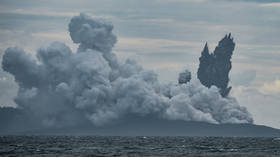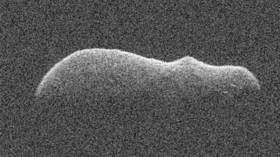Biggest tsunami ever? New study reveals disastrous aftermath of dinosaur-killer asteroid

The asteroid strike that killed the dinosaurs also created a colossal tsunami with waves as tall as 1.5 kilometers, according to researchers who created a new simulation of the impact and its aftermath.
The tsunami caused by the Chicxulub asteroid’s impact was unlike anything humanity has ever seen, according to University of Michigan researcher Molly Range, who presented the study at the American Geophysical Union last month.
“It must have been one of the biggest tsunami ever,” said oceanographer Brian Arbic, who also contributed to the study.
Also on rt.com There’s a galaxy hurtling towards our Milky Way that could wipe out life on EarthAfter the nearly mile-high wave, which represents just “the initial blast of water away from the impact,” water rushed back into the crater left by the asteroid’s impact, triggering another massive wave. The asteroid’s impact would have been felt all around the world, with waves in both Atlantic and Pacific Oceans reaching 14 meters and growing taller as they approached land, while the Gulf of Mexico was roiled by waves reaching 100 meters in height.
To compare these aquatic behemoths with modern waves, the largest wave humans have ever recorded in the Southern Hemisphere hit New Zealand last year. It was “only” about 24 meters tall. The researchers found this tsunami was about 2,600 times as powerful as the December 2004 Indian Ocean tsunami, one of the most intense on record.
A second model illustrated the proliferation of Chicxulub’s waves, which encircled the globe within 24 hours, sometimes moving as quickly as 143 kph. They confirmed the results with a study of sediment records, which revealed disturbances as far as 6,000 kilometers away from the impact site.
Chicxulub hit the shallow waters around where the Yucatan peninsula is located today approximately 66 million years ago, setting in motion the chain of events that would lead to the extinction of the dinosaurs and pave the way for the rise of the great apes. Besides creating the monster tsunami, the asteroid triggered shock waves and rocketed hot dust and rock into the atmosphere, literally cooking animals alive even as some of the particles blocked the rays of the sun, interrupting photosynthesis and disrupting the food chain.
Think your friends would be interested? Share this story!













